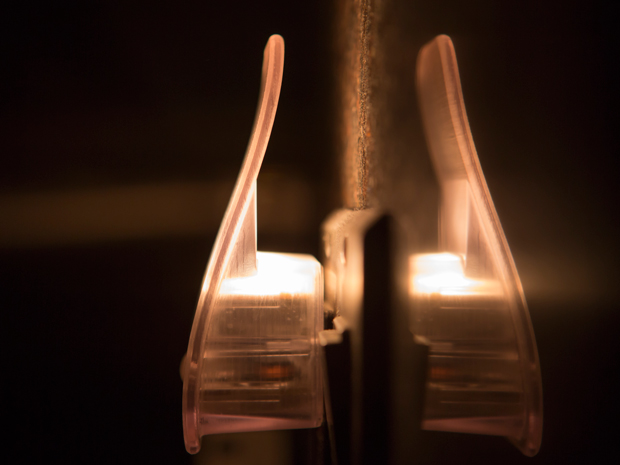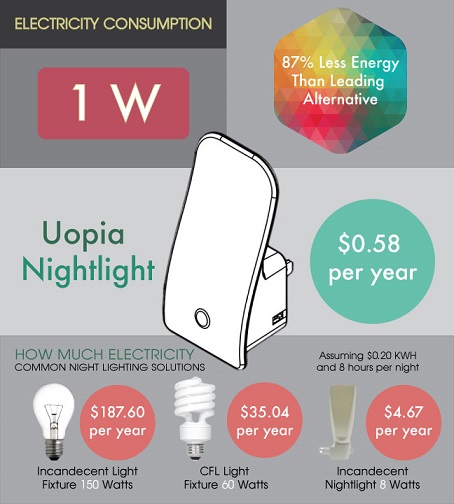The number of people experiencing sleep related issues around the globe is at an all-time high. In the United States alone, poor sleep quality has become so pervasive that the Center for Disease Control has classified it as an epidemic. Researchers have identified that short wavelength blue light in the 460 to 480 spectrum inhibit natural sleep patterns and lead to sleep disorders. The San Jose based startup, Uopia, is taking a different approach to helping you get better sleep by designing a nightlight that helps stabilize your circadian rhythm. The nightlight produces warm light with minimal levels of blue wavelengths in order to reduce the impact of artificial lighting on circadian rhythms.
 |
Uopia Nightlight helps melatonin levels in your body stay at maximum to allow a better night's sleep. (photo courtesy: Uopia)
|
The science behind the Uopia Nightlight is simple. Our body uses sunlight to maintain our circadian rhythm, the body’s internal clock. Much like how your ears are critical to your perception of balance, your eyes regulate your sleep cycle. Photoreceptors in your retina are responsible for responding to light in the 460-480 spectrum, found abundantly in sunlight. When this spectrum of light is present, our body responds by suppressing the production of the hormone melatonin to help us stay awake and alert.
Melatonin is responsible for inducing the sensation of drowsiness and facilitating our body’s transition into the deep REM sleep we need to wake up feeling refreshed each day. Unfortunately, most modern lighting--including light from mobile devices, computers and televisions--emits high levels of the blue light found in this range. As a result, our body is tricked into producing lower levels of melatonin, making it harder to fall asleep, and giving us less critical REM sleep. Using the Uopia nightlight before bed and throughout the night will ensure that melatonin levels are at a maximum.
Most LED based products on the market today emit melatonin-suppressing blue light, which can be helpful for staying awake and being alert during the day, but can be detrimental to sleep patterns, especially for children and young adults. Other ill effects of a sub-optimal circadian rhythm include decreased concentration, alertness and memory performance as well as an increased risk of certain types of cancers, diabetes, depression and obesity.
Being aware of the effects of nighttime exposure to light and making some basic changes around bedtime routines can go a long way toward getting you sleeping better and feeling more energized during the day. Here are some relatively easy steps you can take to limit your exposure to blue light:
• Try making the last 1-2 hours before bed electronic free. Phone screens, tablets, monitors and TVs are all rich in harmful blue light. Limiting your use of these devices before bedtime may increase your melatonin production by up to 22%.
• If living without your electronics is out of the question, you can still help yourself by installing color temperature changing software like f.lux on all your devices to limit your exposure to blue light.
• Increase daytime exposure to both sunlight and artificial light. Daytime exposure can help strengthen circadian rhythms and boost daytime alertness, leaving you better prepared to sleep when the time comes.
• If you get up in the middle of the night and need access to light, use small nightlights rather than switching on bright hallway or bathroom lights that are not optimized for evening safe color temperatures.
In addition to the added sleep benefits, the Uopia nightlight boasts elegant aesthetics, 50,000 hour ultra long life expectancy and increased energy efficiency over typical incandescent lights. If you want to be one of the first to support to take advantage of this new technology, support Uopia’s Kickstarter campaign or head on over to http://www.uopia.com to learn more.













